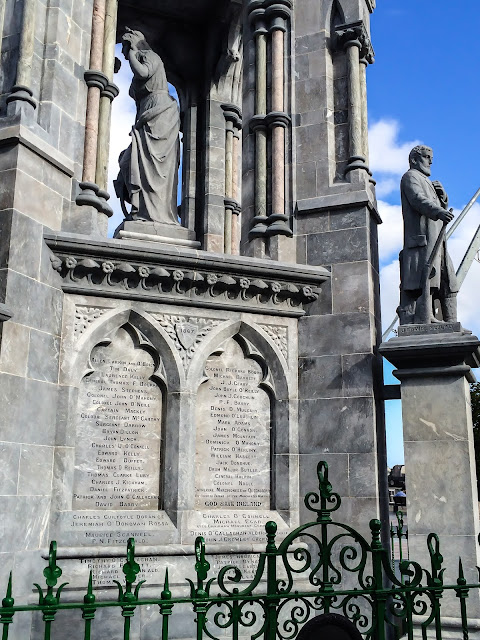IRELAND #6: BLARNEY CASTLE AND CORK
Next, we travelled to Cork. On the way, we visited Blarney Castle. While in Cork, we drove a few kilometres to the sea and visited the port of Cobh (pronounced "cove"). We also wandered through the centre of Cork, and enjoyed dinner with a local family. It was a further probe into the depths of Irish culture - very enjoyable!
A few kilometres north of Cork, Blarney Castle, now a partial ruin, was built in 1446. A typical "tower house" of the time, it was designed as a fortified residence with its own tower. It was built on the site of earlier fortifications. The tall square house has several accessible rooms. On its projecting parapets, 127 steps up from ground level in the keep, rests the famous Blarney Stone.
Many of our group decided to climb the 127 steps to the battlements to kiss the Blarney Stone. We all lay on our backs, upside-down and backwards over the sheer drop, to kiss the stone. This action gave some of us the gift of "eloquence". Unfortunately, I did not get a photo. However, the conversations on our tour bus were remarkably more erudite after this kissing!
In this photo, notice the small patch of blue sky in the very dark area under the projecting parapet above the double window. That is where we hung upside-down to kiss the Blarney Stone.
The gardens surrounding the castle are extensive, and the walkways are unique. They include interesting natural rock formations, streams, and waterfalls, many of which have been given names such as "Witch's Cave", "Druid's Circle", and "Wishing Steps".
On the south side of Cork, the seaport town of Cobh is located on the second largest natural harbour in the world. We spent time on the waterfront learning about the very rich history of Cobh - in ship-building, in naval history, in emigration, and tourism. It was the departure point for 2.5 million Irish who emigrated to North America between 1848 and 1950.
On the waterfront stands a statue of Annie Moore and her two brothers. (Annie was the first person admitted to the USA through Ellis Island New York in 1892.) Annie symbolizes the incredibly difficult separations that have occurred between individual Irish persons and their families and their homeland over many centuries.


Cobh (called Queenstown at the time) was the last departure point for the Titanic as it steamed across the Atlantic Ocean on its maiden and only voyage on April 11, 1912. The building on the right in the next photo is the office of the White Star Line from which the passengers loaded onto tenders to be taken to the Titanic.


This memorial commemorates the Titanic and her last port of call, and is dedicated to the memory of the Irish emigrants and all those who lost their lives in this great tragedy.
The technology of the Titanic and the lives of those who were affected by her is displayed in an interactive museum on the waterfront.
Cobh was the nearest port when the passenger ship Lusitania was torpedoed and sunk by a German submarine on May 7, 1915. This memorial is dedicated to those residents of Cobh who rescued the survivors and buried the dead. It was erected to the memory of those who perished.
Near the hilltop St. Colman's Cathedral, a row of steeply terraced houses drew the attention of our camera-ready tourists. I decided to include several views here.
We took a peek inside St. Colman's Cathedral and discovered that some organ restoration work was under way.
Back in the centre of Cork (population 120,000) some of us visited the English Market. It is a covered fruit and vegetable market that was established in 1610. I found that the fish for sale provided the most interesting photographic subjects.
Near the centre of Cobh, on Grand Parade, we found the National Monument which focusses on Irish nationalists of the 19th century. It struck a chord with me because the Fenian Raids on Canada launched from the USA between 1866 and 1871 were connected with some branches of these Irish nationalists. (This was a formative event in Canadian history.)
While wandering down South Mall, we came across this amusing "Hear no evil, See no evil, Speak no evil" pub.
The final view in Cork shows the south channel of the Lee River looking east toward Holy Trinity Church.













































1 Comments:
Great post, Dad (except for the fish). Cork and Blarney Castle look like real highlights from your trip.
Post a Comment
Subscribe to Post Comments [Atom]
<< Home